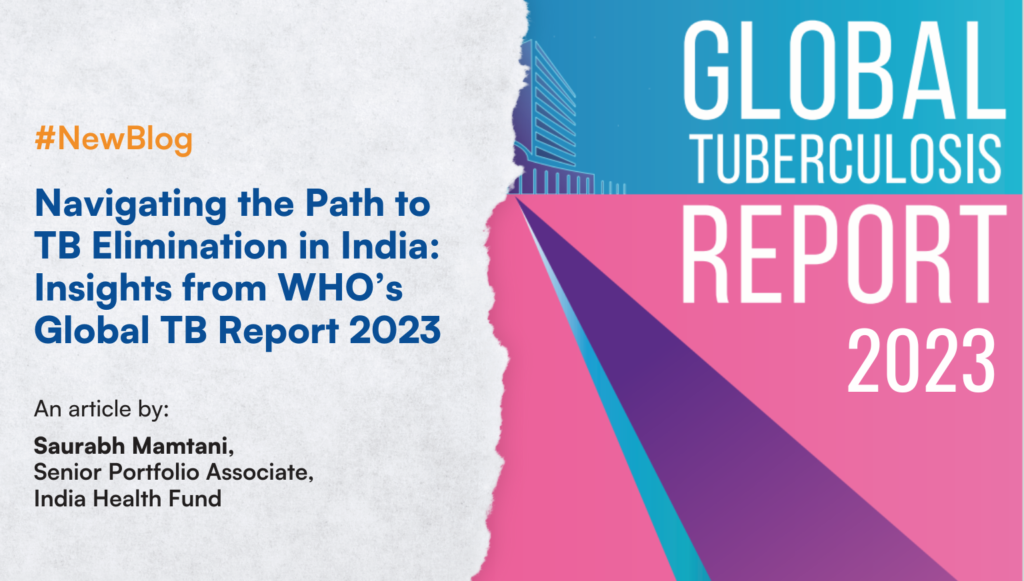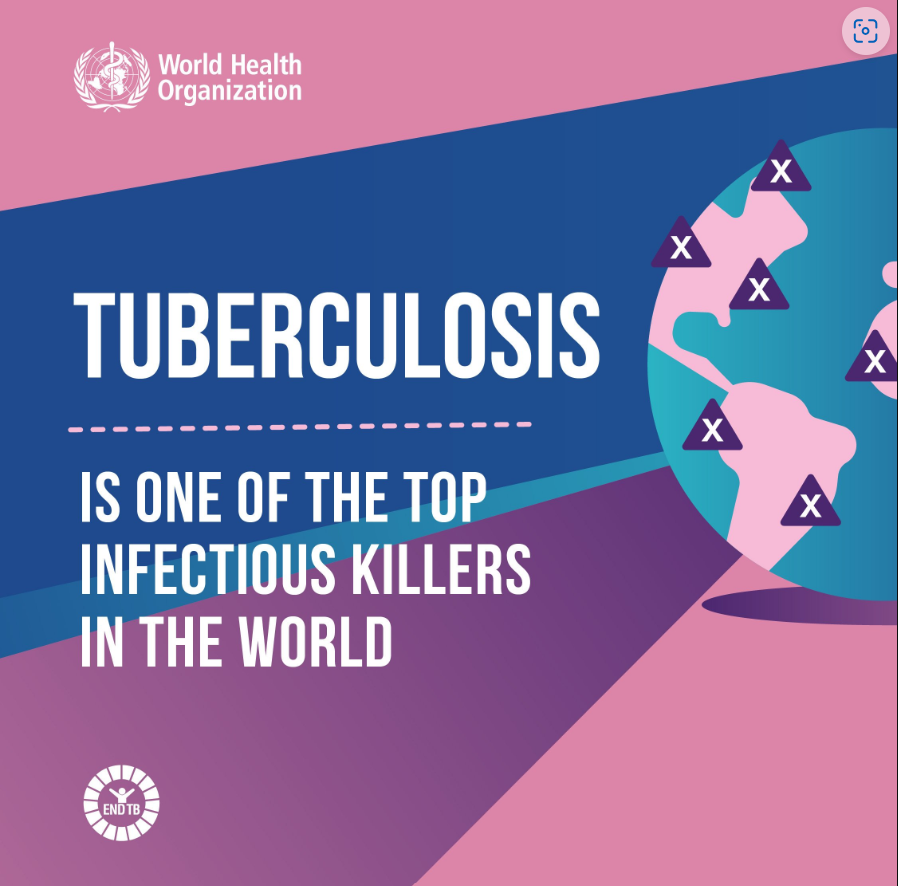

In 2022, India accounted for 27% of the global TB cases, noted the Global TB Report, published by the World Health Organization (WHO) on 7th November 2023 [1]. The 2.42 million TB cases reported in India surpassed the pre-Covid-19 levels of 2.40 million. The number of reported cases of Drug-Resistant TB (DR-TB) including Multi-Drug Resistant & Rifampicin Resistant-TB was 64.4K, which was almost near the pre-Covid-19 level of 66,359 cases [1].

Source- Press Information Bureau- India
The report placed a profound emphasis on the reduction in mortality attributed to TB in India – from 494,000 in 2021 to 331,000 in 2022, which also reduced India’s contribution to Global TB mortality from 36% in the previous years to 27% in 2022 [3]. This dramatic reduction was majorly due to the use of a different data source – India’s Sample Registration System (SRS) dataset instead of relying (as in previous years) on the Global Burden of Disease report. The SRS, involving a sample population of about 8 million people, provides nationally representative data on vital events including births and deaths based on verbal autopsy. The new estimates, accepted for the first time by WHO, were developed in collaboration with India’s Ministry of Health and Family Welfare and were informed by discussions with the Institute for Health Metrics and Evaluation (IHME) [1].

While mortality is one significant indicator of the disease burden, another important one that takes into consideration the plight of the people suffering from the disease is Disability Adjusted Life Years (DALYs). DALYs take into account Years of Life Lost (YLL) and the Years of Life lived with Disability/Disease (YLD). While the data for 2022 is unavailable, in 2019 Tuberculosis was responsible for causing 1810.22 DALYs per 100,000 population in India and accounts for 3.5% of total DALYs in India. As a comparison, Covid-19 caused 1022 DALYs per 100,000 population in the year 2020 [2].
The report highlighted that India’s intensified case detection strategies have resulted in the highest-ever notification of cases in 2022, despite having a sizeable backlog owing to disruptions linked to Covid-19 pandemic [3]. The key initiatives launched and scaled up by the government like specialized active case finding drives, scaling up of molecular diagnostics to block levels, decentralization of screening services through Ayushman Bharat Health & Wellness Centres, and private sector engagement have resulted in significant detection of TB cases after the setback from Covid-19. These initiatives have also allowed India to complete the National TB prevalence survey since 2019, becoming the only country to do so [4]. Results from this survey were a key input to the estimates of TB incidence in India published in the Global TB Report 2023 [3].
India has set a target of 2025 for eliminating TB in the country. The national strategic plan 2017-2025 sets the target of no more than 44 new TB cases per 100,000 population by 2025 [5]. At present, this number stands at 199 cases per 100,000. Achieving the envisioned target of the national strategic plan is a big task as the plan had envisaged an incidence of only 77 cases per 100,000 population by 2023. The program also aims to reduce the mortality to 3 deaths per 100,000 population by 2025, which currently stands at 23 per 100,000 population.
Expanding access to rapid diagnostics for improved TB reporting will remain critical to reaching national and global TB control targets. The pivotal significance lies in prioritizing TB diagnosis before any meaningful impact from novel treatments can be realized. In essence, the ability to effectively treat TB hinges on our ability to first identify it. Without an accurate and rapid diagnosis, the goal of eradicating TB remains unattainable [6].
To reach the target of achieving 100% coverage of rapid diagnostic testing, which was set in 2023 at the second UN high-level meeting on TB, we need to close the gap between reported cases and estimated disease burden. In 2019, the estimated number of people having TB in India was 2.6 million, whereas in 2022 it was 2.8 million. However, the cases reported in 2019 were 2.40 million, and those in 2022 were 2.42 million. The gap between estimated and reported cases in India has increased approximately 1.9 times. To bridge this gap between the estimated and reported cases there is a need for wide access to diagnostic services at the point in the health system where patients first seek care, which is usually the lowest level of healthcare. Despite significant investments in laboratory systems strengthening in recent years, development of tests suited for primary care levels has remained a key gap in the patient cascade for TB.
Latest technologies like smartphone-enabled detection tools, digital pathology solutions, PCR and LAMP-based RDTs, hand-held X-rays, AI/ML image processing approaches, microfluidics for point-of-care (PoC) PCR testing, and PoC tools for whole genome sequencing, etc. hold the potential to bridge this gap. Finding and funding the development and deployment of such point-of-care future-facing innovations will be critical to reducing the TB burden in India and beyond. This is where India Health Fund steps in.
India Health Fund (IHF), a Tata Trusts initiative, stands as a beacon of hope and progress in the realm of TB diagnostics. Nurturing tools and technologies for better diagnosis of infectious diseases like TB is one of the key focus areas of IHF. Operating in a space often overlooked by private entities due to market failures and inadequate government funding in India’s R&D sector, IHF has been filling a crucial void in TB. As one of the top philanthropic funders for TB, IHF exemplifies its commitment to driving positive change, aligning with the goal of achieving the annual funding target for TB research of US$ 5 billion by 2027, as set by the second high-level UN meeting on TB. The TB diagnostic innovations backed by IHF, including Truenat, Qure.ai, Healseq, Stellar, and Omix hold immense potential to positively impact the lives of hundreds of thousands of TB patients in India and beyond.
Saurabh Mamtani is a Senior Portfolio Associate at India Health Fund. He is a dedicated public health professional with a diverse background in health economics and pharmacy. He holds an MSc in Public Health from the London School of Hygiene and Tropical Medicine and a Doctor of Pharmacy (PharmD) from India. His work spans diverse areas, including healthcare, consulting, project management, and research, where he has consistently contributed to evidence-based decision-making for positive social impact. Saurabh is driven by a profound sense of purpose to serve humanity, tackling intricate social challenges, and advocating for practical solutions on a global scale.